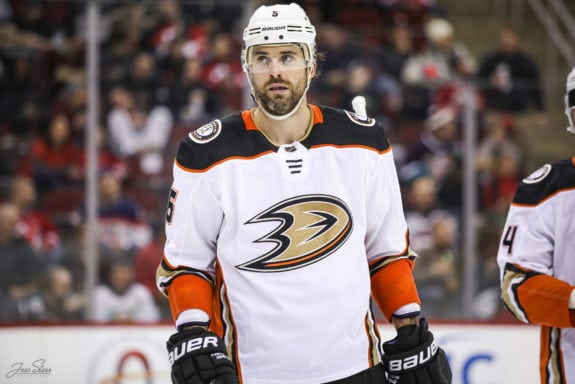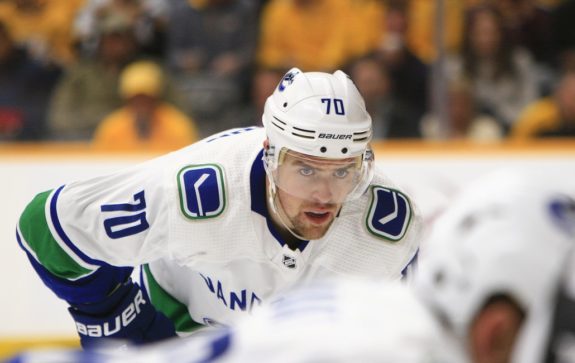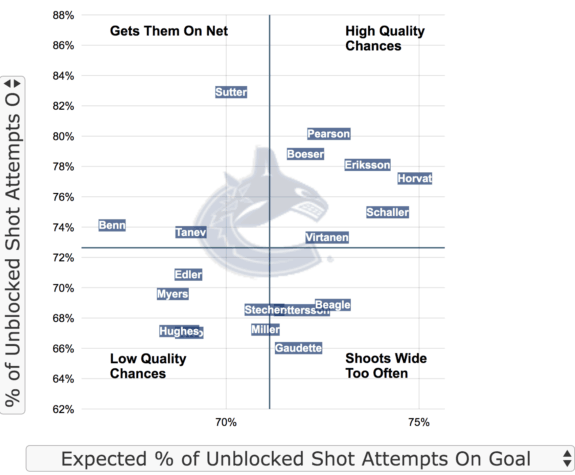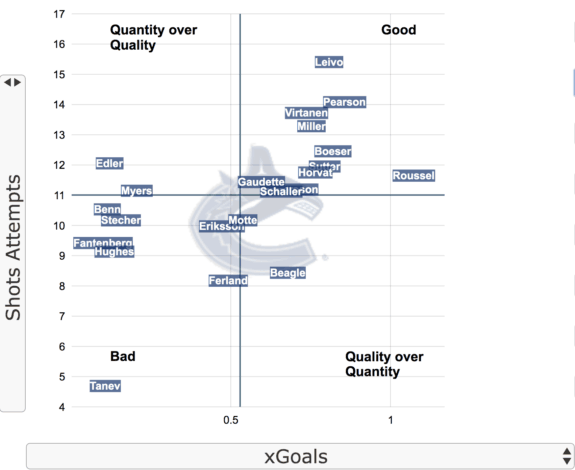A little under a year ago, the Vancouver Canucks and the Pittsburgh Penguins reached an agreement to swap Erik Gudbranson for Tanner Pearson in a one-for-one trade.
Gudbranson’s Journey
Canucks fans rejoiced as Gudbranson had a rough time during his three years in Vancouver, providing little value other than looking handsome – mostly while sitting in the penalty box.
He ranked dead last for Canuck defencemen in Corsi, Fenwick, goals for and scoring chances for – must I go any further? Gudbranson lasted a mere 26 games with Pittsburgh before being shipped to the abysmal Anaheim Ducks earlier this season.

The Ducks are bad – really bad. Just how bad? Well, Gudbranson is a top-four defenceman for them. However, he has been playing better hockey of late. Nonetheless, he would not have fit on a young and contending Canucks team that is already up against the cap ceiling with expiring entry-level contracts looming.
Pearson Flourishing With Canucks
Safe to say, the Canucks were fortunate to be freed of Gudbranson’s $4 million annual cap hit. Any production from the more affordable Pearson was a pleasant bonus as he is filling a dire need Vancouver has had for ages; a winger for Bo Horvat.
“He’s been a 40, 45-point guy in the league,” explained general manager, Jim Benning. “We think he’s going to be a good fit with either (Elias Pettersson) or (Bo Horvat). He’s just another guy that can score for us.”
Pearson has been that and more. He has accumulated 46 points in just 65 games since his arrival, good for a 60-point pace. Even better, Pearson has been increasingly improving his production.

In his first 19 games with Vancouver, he scored at a 0.63 point-per-game pace, significantly superior to his prior career average of 0.42. This season, Pearson has recorded a point in 73 percent of games.
Over the last 30 games, Pearson leads Vancouver with 28 points, translating to a stellar 0.93 points-per-game.
Empty Net King
However, this stat is slightly misleading as Pearson has been the king of the empty net goals (don’t tell Pekka Rinne) collecting six points on empty-net goals making his totals slightly less glamorous but still impressive. Especially considering that Pearson almost never sees top unit power-play time but instead has been able to spark the second unit with much less time allotted.
I would not expect Pearson to lead the Canucks in scoring for such a long stretch again, considering the offensive arsenal Vancouver now possesses and his puck luck with the empty net. However, I also cannot knock coach Travis Green for putting Pearson out on the ice to seal games or Pearson for being hungry to corral those empty net cookies either.

It shows that when the game is on the line, Green trusts Pearson’s line to defend the lead. That is exactly what he’s done. When the Canucks have the lead, only Adam Gaudette and Loui Eriksson have allowed fewer goals against than Pearson, who has allowed seven. However, both those players have played more than 75 minutes less than Pearson in those situations.
The empty-net goals are somewhat of a reward for that hard work done defending late in games. I have much faith in the first line being capable of defending the lead too, however, it makes sense that Green may be leery of using them in high volume shot-blocking situations.
The Canucks have only given up two goals with the other teams’ goalie pulled – only four teams have allowed less. Contrasted with eight empty net Goals For, the Canucks hold the league’s seventh-best Goals For percentage with an opposing empty net.
Second Line Success
If it ain’t broke, don’t fix it. The line of Pearson, Eriksson and Horvat will continue to be counted upon in these critical situations.
A lot of Pearson and that line’s success is in credit to Horvat’s exceptional play recently. Horvat has been on a tear, recording five goals and twelve points in the last seven games. The newly minted captain is the big, strong center that drives the offence and carries the puck for that line.
To the delight of Horvat, Pearson has established himself as the first consistent winger on the second line since Horvat’s emergence as a top-six player. They have succeeded because of Pearson’s ability to create high-quality chances which typically result in either goals or juicy rebounds (where he ranks second on the team for forwards according to natural stat trick).

The top left portion of the graph displays the players who create the highest expected goals per 60 minutes combined with shot attempts per 60 minutes – calculating which players produce good quality and quantity shots.
Essentially what expected goals takes into consideration are factors like distance from the net, angle taken, type of shot and what occurred previous to the shot.
While Pearson produces great and frequent shot attempts, he also manages to get more of them on net than expected.

Once again, the top left portion of the graph contains the players who produce a higher amount of unblocked shots on goal than their expected amount – resulting in the highest quality chances. This shows Pearson makes 80.17 percent of his unblocked shot attempts on goal while only being expected to have 72.7 percent of shots to be on goal.
This model adjusts for the score in the game at the time that the unblocked shots occurred. For example, teams generally take more unblocked shot attempts when trailing by a goal. Therefore, shot attempts in that situation are at a nine percent discount. Included in this model are shots on goal and shots that miss the net at five versus five play.
Last and also least is Eriksson’s addition to the line. He may provide the least offensive production but the maligned Eriksson is playing some of his best hockey as a Canuck and slightly improves the line as a unit. While Eriksson may not have been the final missing ingredient for this line, with him they spend less time in their own zone and Eriksson goes to the dirty areas drawing defenders away from higher skilled like players Horvat and Pearson.
I believe the identity of this line was perfectly exemplified during the goal against the Wild on Sunday. Horvat carries the puck into the zone where his shot is deflected and rings around the boards to Pearson. The Kitchener native throws the puck on net where Wild goaltender Devan Dubnyk sees Eriksson jolting towards the puck as if it were an opportunity for a buyout out of Vancouver. Horvat is able to slide the puck past the distracted Dubnyk to score the clinching goal for that game.
Was it pretty? No. Was it downright disgusting? Kind of.
But those types of goals are extremely valuable come playoffs. Pearson was a Stanley Cup champion with the Los Angeles Kings in 2014 and scored 12 points in 24 games as a rookie. Yes, as a rookie!
With opposing teams’ top defensive lines focussing in on players like JT Miller, Brock Boeser and Elias Pettersson in the playoffs, it is extremely important to have reliable production from the second line. Luckily for the Canucks, this seems to be an issue that has been resolved just in time for that desperately desired playoff appearance.